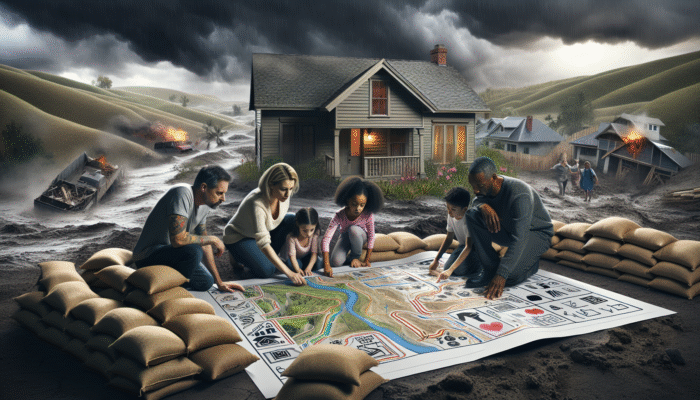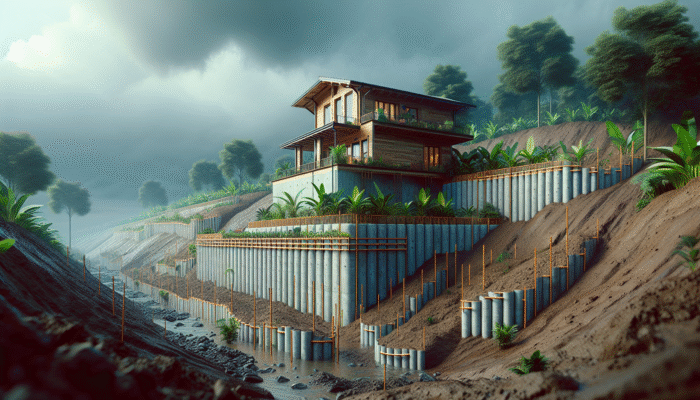Comprehending Mudslides: Key Causes, Associated Risks, and Effective Preparedness Techniques
Surviving a mudslide demands more than mere luck; it necessitates a thorough understanding of this powerful natural occurrence. Mudslides can inflict substantial damage to both landscapes and communities, arising when gravity pulls saturated soil and debris down steep slopes at alarming speeds. Numerous factors contribute to these disastrous events, including intense rainfall, rapid snowmelt, and seismic activities. To successfully prepare for and endure a mudslide, it is essential to grasp the fundamental causes, identify warning signs, and explore the various types of mudslides. This comprehension is vital for ensuring personal safety and protecting property.
Identifying the Main Factors Leading to Mudslide Incidents

The predominant catalyst for most mudslides is heavy rainfall; however, it is crucial to recognise that the sheer volume of water is not the sole determinant of a mudslide's occurrence. Soil saturation plays a pivotal role; once the ground reaches its maximum absorption capacity, any additional moisture creates a precarious situation that leads to instability. This condition can develop rapidly, particularly in areas characterised by steep terrain or loose soil. Additional contributing factors include <a href="https://limitsofstrategy.com/sustainable-cutting-board-essential-tips-for-selection/">deforestation</a>, urban development, and the geological characteristics of a location. For example, volcanic activity can disturb soil layers, while the removal of vegetation eliminates the root systems that typically serve to stabilise the earth.
In regions such as California, mudslides often follow wildfires, as the absence of vegetation reduces natural barriers against soil erosion, particularly during intense rainfall. Similar trends are observed in Brazil, where deforested slopes are especially susceptible to catastrophic mudslides during the rainy season. By comprehending these causative factors, communities can enhance their ability to predict potential mudslide events and implement effective prevention measures to mitigate associated risks.
Identifying the Key Warning Signs of an Approaching Mudslide
Being vigilant to the signs of an impending mudslide can be critical for survival. Unusual noises, such as rumbling, cracking, or the movement of debris, may indicate that a mudslide is on the horizon. Indicators of ground movement, including visible cracks in the soil and trees leaning at unnatural angles, should not be overlooked. Additionally, any sudden shifts in water flow, such as streams swelling unexpectedly or changing direction, signal the need for immediate action.
For those residing in areas prone to mudslides, educating oneself about these warning signs is essential. Understanding local geological and climatic conditions can provide context for when heightened vigilance is necessary. For instance, in places like the Andes in Peru, where heavy rainfall is prevalent, residents must remain alert following extended periods of rain. The ability to identify early warning signs can be life-saving and significantly enhance emergency preparedness efforts.
Examining the Different Types of Mudslides and Their Potential Consequences
Understanding the various types of mudslides is crucial for effective risk assessment and preparation. The most common forms include debris flows and mudflows, which differ in composition and speed. Debris flows consist of a combination of water, rocks, and vegetation that can race down slopes with astonishing velocity. Conversely, mudflows are primarily made up of water and fine sediment, typically moving at a slower pace but still presenting substantial risks.
The term “landslides” encompasses a wider range of events, including rockfalls and soil erosion that may occur independently of water. Each type of mudslide poses unique threats; for example, debris flows can be particularly destructive due to their rapid speed and density. Meanwhile, mudflows, although slower, can inundate areas with significant volumes of water and mud, leading to extensive destruction. Grasping these distinctions allows communities to develop targeted response strategies and create effective risk mitigation plans customised to their specific vulnerabilities.
Proactive Strategies for Preparing for Possible Mudslide Events

Preparation serves as a cornerstone of surviving a mudslide. Taking proactive measures can significantly mitigate the risks associated with these natural disasters. From developing a comprehensive emergency plan to fortifying your home, each action plays a vital role in ensuring readiness for potential mudslides.
Crafting a Thorough Family Emergency Plan
The creation of a detailed family emergency plan is a foundational step in effectively responding to a mudslide. Begin by identifying clear evacuation routes from your home and the surrounding community, ensuring they lead to higher ground that is safe from potential mudslide zones. It is prudent to map out multiple routes, as some may become obstructed during an emergency.
Equally important are strategies for communication. Establish a reliable system for all household members to check in and confirm their safety during emergencies. Designate a specific meeting place where family members can gather after a crisis has occurred. In regions prone to mudslides, these preparedness measures can significantly improve safety prospects. Moreover, consider incorporating local resources, such as community alert systems or mobile applications that provide real-time updates on weather conditions and potential hazards.
Areas like the Appalachian Mountains in the United States are particularly vulnerable to mudslides. Residents in such regions should tailor their emergency plans to address local risks and ensure regular practice of these strategies. Practising these plans not only builds confidence but also fosters a sense of readiness when faced with potential disasters.
Gathering a Life-Saving Emergency Kit
Having a well-stocked emergency kit can be a lifesaver during a mudslide event. Assemble a kit that includes essential supplies, such as water—at least one gallon per person per day for a minimum of three days—and non-perishable food items to sustain your family for the same duration. Do not forget to include a first aid kit, flashlights with extra batteries, and protective gear like helmets and gloves.
Consider adding items tailored to your specific environmental context. For example, if you reside in a region frequently affected by mudslides, include tools for clearing debris or a whistle to signal for help. It is also advisable to keep important documents, such as insurance papers and identification, in a waterproof container.
Accessibility is crucial for your emergency kit; store it in a location that is easy to reach during an emergency. Regularly inspect the contents and replace any expired items to ensure everything is ready for use when needed. Taking this proactive approach can significantly enhance your chances of surviving a mudslide and enable you to respond swiftly and effectively when disaster strikes.
Implementing Home Reinforcement Techniques to Combat Mudslides

Securing your home against mudslides is an essential aspect of disaster preparedness. Implement measures to reinforce your walls and install barriers designed to redirect the flow of mud away from your property. Building retaining walls can effectively stabilise soil, provided they are engineered and constructed to withstand the pressure exerted by moving earth.
Another critical step is to clear away debris and vegetation near your home. This action not only diminishes the risk of accumulation during a mudslide but also reduces the likelihood of erosion around your foundation. Consider landscaping with native plants that possess deep root systems, which can help stabilise soil and prevent erosion.
In regions like the Pacific Northwest, where mudslides occur due to heavy rainfall, homeowners should routinely inspect their properties, particularly after storms, to identify potential hazards. Consulting with professionals who can offer insights into mudslide-resistant construction techniques tailored to local conditions can also be advantageous.
Key Actions to Take During a Mudslide Emergency
When a mudslide strikes, every second is of the essence. Knowing the appropriate actions to take in the moment can be the decisive factor between life and death. From immediate responses to self-protection strategies, being informed is your greatest defence against this natural disaster.
Critical Immediate Actions for Survival During a Mudslide
If you find yourself in the path of a mudslide, your primary instinct should be to move to higher ground without delay. Avoid river valleys or low-lying areas, as these locations are often the first to be inundated during a mudslide. The astonishing speed at which mudslides can travel—some reaching up to 35 miles per hour—leaves little room for escape.
Stay alert to your surroundings and heed any warnings issued by local authorities. If you hear alarms or see emergency personnel directing evacuations, comply with their instructions without hesitation. Use a map or familiar landmarks to navigate to safety, especially if visibility is compromised by debris or mud.
Preparedness may also necessitate having a backup plan in case your primary escape route becomes obstructed. Familiarity with alternative paths can be invaluable during such a crisis. In mudslide-prone areas, local communities often conduct drills to help residents become familiar with these evacuation routes, thereby increasing overall preparedness.
Personal Protection Strategies to Implement During a Mudslide
When confronted with a mudslide, personal protection is paramount. Utilise any available materials, such as jackets or backpacks, to shield your head and torso from falling debris. The impact of mud, rocks, and other materials can be severe, and any barrier can help mitigate the severity of injuries sustained.
If you are swept away in a mudslide, attempt to stay upright and move with the flow of the mud as much as possible. This approach can help you avoid being trapped beneath debris. Should you be knocked off your feet, curling into a ball can protect your vital organs from injury.
Remain vigilant and aware of your surroundings. Look for any potential escape routes and be prepared to adjust your movements as necessary. By focusing on your personal protection, you enhance your chances of surviving this chaotic and unpredictable natural disaster.
Maintaining Composure Amidst the Turmoil of a Mudslide
Panic can be counterproductive and even fatal during a mudslide. It is crucial to maintain composure, as this is essential for making rational decisions that enhance your survival prospects. Visualise the actions you need to take and concentrate on executing them as efficiently as possible.
Utilising breathing techniques can help manage anxiety. Take deep breaths to centre yourself and lower stress levels, which can enable clearer thinking. Encourage those around you to remain calm as well; collective composure can facilitate better decision-making and coordinated responses.
In tumultuous situations, remember that focusing on immediate survival actions can prevent paralysis by analysis. By maintaining a calm and collected mindset, you improve your ability to process information and respond effectively, which is vital for surviving a mudslide.
Effective Strategies for Signalling for Assistance
Once you have ensured your immediate safety, signalling for help should become your priority. Use a whistle or flashlight to attract the attention of rescuers. If you are unable to move due to injuries or debris, shouting for help can also be effective, but remember to conserve your energy.
In areas susceptible to mudslides, local emergency services often have established protocols for responding to victims. Familiarising yourself with these resources ahead of time can save valuable moments when every second counts.
Clearly communicate your location to rescuers; if you have a smartphone, utilise it to send your GPS coordinates. The quicker you convey your needs, the faster assistance can arrive, significantly improving your chances of survival.
Steps for Recovery Following a Mudslide
The aftermath of a mudslide can present challenges as formidable as the event itself. Assessing damage, seeking assistance, and conducting clean-up operations safely are vital steps in the recovery process.
Conducting a Thorough Damage Assessment
Once the immediate danger has passed, it is essential to carefully assess the condition of your property. Before re-entering your home, ensure the structure is stable and secure. Look for cracks in the walls, leaning structures, or any other indicators of damage. If you observe signs of instability, avoid entering the area and contact professionals who can accurately assess the risks involved.
Be vigilant for potential hazards, including exposed electrical wiring, gas leaks, and contaminated water supplies. After a mudslide, these hazards can pose significant threats to your health and safety. Additionally, documenting the damage for insurance purposes is crucial; take photographs and gather pertinent information to support your claims.
For residents in areas susceptible to mudslides, understanding the potential risks can significantly assist in the assessment process. Local geological surveys often provide valuable insights into land stability and potential risks, which can inform decisions regarding repairs and rebuilding efforts.
Seeking Help and Available Resources
After evaluating the damage, reaching out for assistance becomes critical. Contact local emergency services to report your situation and request help. Many communities have relief organisations ready to provide support following disasters, such as mudslides.
Don't hesitate to seek help from friends, family, and neighbours as well. Community support can be invaluable during the recovery process. Local charities may offer resources such as food, clothing, or temporary shelter for those displaced by the mudslide.
In addition to immediate assistance, consider reaching out to organisations that provide long-term recovery support. These groups often offer resources for rebuilding and can help you navigate the complexities of insurance claims and grants available for disaster recovery.
Implementing Safe Clean-Up Procedures
Cleaning up after a mudslide requires careful planning to ensure safety. Always wear protective clothing, including gloves, boots, and masks, to prevent injuries and exposure to harmful substances. Exercise caution when moving debris, as unseen hazards may be lurking beneath the surface.
Utilise appropriate tools, such as shovels and brooms, to clear away mud and debris. Working in teams can enhance efficiency and safety; having others around can provide crucial support during what may feel like an overwhelming task.
Stay informed about local guidelines for debris disposal and safety measures. In some regions, public health departments may provide resources to ensure safe clean-up practices. By taking these precautions, the clean-up process can become more manageable and less hazardous.
Formulating a Sustainable Long-Term Recovery Strategy
Recovering from a mudslide is a journey that requires resilience and careful planning. From rebuilding your home to addressing emotional impacts, each step is critical for achieving successful recovery.
Reconstructing Your Home with Safety and Resilience in Mind
Rebuilding after a mudslide necessitates meticulous consideration of construction techniques. Collaborate with professionals who specialise in mudslide-resistant construction to ensure your new home is equipped to withstand future threats. Techniques may include reinforced foundations, effective drainage systems, and the use of materials designed to resist erosion.
Additionally, consider the layout of your property. Positioning your home away from steep slopes and ensuring proper grading can help mitigate future risks. In regions like the Rocky Mountains, local building codes may provide guidelines on best practices for construction in areas vulnerable to mudslides.
Investing in technology, such as early warning systems, can also be advantageous. By staying informed about weather conditions and geological assessments, you can make proactive decisions that safeguard your home and family.
Tackling Emotional Recovery Post-Mudslide
The emotional toll of a mudslide can be profound, often leading to stress, anxiety, and even post-traumatic stress disorder (PTSD). It is crucial to seek support from friends, family, or professional counsellors who can assist you in navigating these feelings.
Participating in community support groups can also prove beneficial; connecting with others who have experienced similar trauma fosters understanding and healing. Sharing your experiences can provide relief and help you discover constructive coping mechanisms.
Prioritising self-care during this process is vital. Engage in activities that promote relaxation and well-being, whether it’s spending time outdoors, practising mindfulness, or pursuing hobbies that bring you joy. Focusing on emotional recovery is just as essential as addressing physical rebuilding efforts.
Preparing for Future Mudslide Events with Lessons Learned
Utilising the lessons learned from your experiences can significantly enhance your preparedness for future mudslides. Conduct a thorough review of your emergency response and identify areas that require improvement.
Consider participating in community preparedness programmes or workshops that focus on mudslide risks. Engaging with local experts can provide valuable insights into emerging technologies and effective disaster readiness strategies.
By remaining informed and proactive, you can foster resilience within your community and bolster collective preparedness for future events. Each step taken not only aids personal recovery but also strengthens the community’s capacity to withstand the unpredictable forces of nature.
Enhancing Community Preparedness to Mitigate Mudslide Hazards
Community preparedness is essential in reducing the risks associated with mudslides. By working together, communities can bolster their collective resilience and ensure the safety of all residents.
Empowering Community Members Through Education on Mudslide Risks
Education serves as a powerful tool in preparing for mudslides. Sharing knowledge and resources within your community can significantly enhance collective preparedness. Organise workshops, community meetings, or public awareness campaigns that emphasise the importance of mudslide awareness and readiness.
Involve local schools, businesses, and organisations in these initiatives. Educational materials can include information about the signs of impending mudslides, emergency planning, and safe practices during and after an event. Engaging the entire community fosters a sense of shared responsibility and encourages proactive measures.
Consider partnering with local authorities to disseminate information through newsletters, social media platforms, or community bulletin boards. By spreading awareness, you empower individuals to take charge of their safety and that of their neighbours.
Participating in Emergency Drills for Mudslide Preparedness
Conducting emergency drills is essential for refining response strategies and ensuring everyone is aware of their roles during a mudslide. Encourage your community to engage in regular emergency drills that simulate a mudslide scenario. These drills allow residents to practise evacuation routes, communication strategies, and safety measures.
Involving local emergency services can lend realism to these drills and provide valuable insights into effective response strategies. Residents can learn from professionals about the best actions to take during a mudslide and how to assist neighbours in need.
Regular participation in drills cultivates a culture of preparedness. Communities that practise emergency scenarios develop greater confidence and a stronger sense of unity, ultimately enhancing their resilience to disasters like mudslides.
Building Resilience Through Community Collaboration
Community resilience extends beyond disaster response; it encompasses a holistic approach to safety and well-being. Collaborate with local governments and organisations to strengthen infrastructure and enhance support systems against mudslides.
Investing in local infrastructure, such as improved drainage systems and retaining walls, can significantly mitigate the risks associated with mudslides. Engage engineers and environmental scientists to assess and advise on effective community planning and development.
Fostering a culture of collaboration is equally important. Encourage local businesses to participate in community resilience efforts, whether through sponsoring preparedness programmes or directly engaging in recovery initiatives.
Building strong, interconnected communities enhances resilience not only in the face of mudslides but in response to various natural disasters. When individuals work together, they create a safety network that benefits everyone involved.
Establishing Effective Emergency Communication Plans for Communities
Effective communication is vital during a mudslide emergency. Developing comprehensive emergency communication plans ensures that residents can swiftly receive and share information during a crisis.
Collaboration with local authorities and emergency services can facilitate the establishment of a robust communication network. This network should encompass various channels, such as social media platforms, text alerts, and community radio stations, to effectively reach all residents.
Encourage residents to share their contact information and sign up for community alert systems. Regular updates about mudslide risks, weather conditions, and local emergency responses can significantly enhance public safety.
Practising these plans during community drills helps residents become familiar with communication protocols. By prioritising effective communication, communities can bolster their overall preparedness and response capabilities during mudslide emergencies.
Utilising Technological Innovations for Enhanced Mudslide Preparedness
The advancement of technology has transformed our approach to disaster preparedness and response. Implementing technological solutions can significantly enhance efforts to predict and mitigate the risks associated with mudslides.
Implementing Early Warning Systems to Save Lives
Utilising early warning systems can save lives during a mudslide event. These systems deploy various technologies, including weather radar, soil moisture sensors, and rainfall gauges, to monitor conditions that may trigger mudslides.
Communities can collaborate with meteorological services to effectively implement these systems. By receiving timely alerts about changing conditions, residents can take proactive measures to evacuate or secure their properties.
In regions such as the Himalayas, where mudslides frequently occur due to steep terrain and heavy rainfall, early warning systems can provide critical information that enables communities to prepare and respond effectively. Integrating local knowledge with advanced technology can improve overall efficacy.
Utilising Monitoring Tools for Enhanced Safety and Risk Evaluation
Utilising monitoring tools such as inclinometers and piezometers can help track soil movement and water levels. These devices provide real-time data on ground stability, allowing communities to assess risks and take necessary precautions.
Inclinometers measure the tilt of the ground, while piezometers monitor water pressure within soil layers. Combined, these instruments provide valuable insights into conditions that may lead to mudslides, enabling timely interventions and informed decision-making.
Local governments and organisations can collaborate with researchers and engineers to deploy these monitoring tools effectively. The data collected can inform community planning and risk assessments, ensuring long-term safety against mudslide threats.
Investigating Engineering Solutions to Reduce Mudslide Risks
Exploring engineering solutions is crucial for mitigating mudslide risks. Retaining walls and drainage systems can effectively stabilise slopes and redirect water flow away from vulnerable areas.
Investing in geoengineering techniques, such as slope stabilization and vegetation management, can help prevent erosion and decrease the likelihood of mudslides. Collaborating with civil engineers and environmental scientists is vital for developing solutions tailored to local conditions and needs.
In regions like the Italian Alps, where mudslides are prevalent, successful engineering projects have demonstrated the efficacy of proactive infrastructure investments. By prioritising engineering solutions, communities can create safer environments and reduce their vulnerability to mudslides.
Leveraging Remote Sensing Technologies for Risk Evaluation
Utilising satellite and aerial imagery through remote sensing technologies can provide critical insights into landscape changes that may indicate mudslide risks. These technologies can monitor changes in land use, vegetation loss, and soil saturation, helping communities assess their vulnerability.
Local governments and organisations can harness this data to develop effective land use planning strategies. By identifying high-risk areas, communities can implement preventative measures before disaster strikes.
Engaging with academic institutions and technology companies can also improve access to remote sensing technologies. By pooling resources and expertise, communities can create comprehensive datasets that inform disaster preparedness and response strategies.
Applying Data Analytics and Modelling Techniques for Proactive Readiness
Employing data analytics to forecast mudslide occurrences can revolutionise disaster preparedness efforts. By analysing historical data, soil composition, and weather patterns, communities can model potential impact areas and identify vulnerable locations.
Collaboration among local governments, researchers, and data scientists can enhance the effectiveness of these models. By integrating community knowledge with advanced analytical techniques, communities can develop informed strategies for risk mitigation.
Educational institutions often offer valuable resources and expertise in data analytics. Communities can leverage these partnerships to gain insights that bolster overall preparedness and resilience against mudslide threats.
Environmental Factors Affecting Mudslide Risks
The relationship between our environment and mudslide risks is significant and must not be overlooked. Understanding these environmental considerations is essential for effective preparedness and long-term recovery.
The Detrimental Impact of Deforestation on Mudslide Risks
Deforestation significantly increases the likelihood of mudslides by destabilising soil and diminishing vegetation cover. Trees and plants play an integral role in anchoring soil; without their root systems, slopes become susceptible to erosion and landslides.
In regions like Southeast Asia, illegal logging practices have heightened the risks of mudslides. Communities must prioritise sustainable land management practices to safeguard against these threats. Reforestation initiatives can help restore areas affected by deforestation, creating a natural barrier against soil erosion.
Involving local communities in reforestation efforts not only heightens safety but also cultivates a sense of environmental stewardship. Raising awareness about the significance of trees in preventing mudslides can encourage responsible land-use practices.
The Influence of Climate Change on Mudslide Frequency and Severity
Climate change profoundly affects environmental stability, influencing the frequency and severity of mudslides. Rising temperatures and shifting weather patterns contribute to increased precipitation and rapid snowmelt, elevating the risk of mudslides on a global scale.
In regions like Central America, changing climate conditions have led to more extreme weather events, resulting in devastating mudslides during the rainy season. Communities must adapt their preparedness strategies to address the realities of climate change.
Investing in climate resilience initiatives, such as improved land management and sustainable agricultural practices, can empower communities to withstand the impacts of climate change more effectively. Collaborating with climate scientists and environmental organisations can enhance understanding of local vulnerabilities and inform proactive measures.
The Role of Biodiversity in Mitigating Mudslide Risks
Biodiversity is crucial for maintaining ecological balance and supporting life, including human societies. Diverse ecosystems contribute to soil stability, water retention, and overall environmental health, which can mitigate the risks associated with mudslides.
Promoting biodiversity through conservation efforts can strengthen resilience against mudslides. Protecting natural habitats and preserving native species helps maintain ecosystem balance, reducing the likelihood of disastrous events.
Communities can engage in local conservation initiatives that foster biodiversity, such as habitat restoration or wildlife protection programmes. A more diverse and stable environment is better equipped to withstand the pressures of climate change and human activities.
Frequently Asked Questions Regarding Mudslides and Safety Protocols
What steps should I take if I live in an area vulnerable to mudslides?
If you reside in a region prone to mudslides, it is imperative to develop an emergency plan, stay informed about local weather conditions, and reinforce your home against potential risks. Regularly review and rehearse your plan with your family to ensure everyone is prepared.
How can I identify the signs of an imminent mudslide?
Indicators of an impending mudslide include unusual sounds, ground movement, cracks in the earth, and alterations in water flow. Maintain vigilance during heavy rainfall and monitor your surroundings for these warning signs.
What essential items should I include in my emergency kit?
Your emergency kit should contain essential supplies, including water, non-perishable food, a first aid kit, flashlights, protective gear, and important documents, all stored in a waterproof container. Regularly inspect and update the contents to ensure they remain ready for use.
What actions should I take if a mudslide occurs?
During a mudslide, move to higher ground immediately, cover your head and torso for protection, and remain calm. Once you reach safety, signal for help using whistles or flashlights to attract attention.
How can communities enhance their preparedness for mudslides?
Communities can bolster their preparedness for mudslides by educating residents, participating in emergency drills, strengthening infrastructure, and developing effective communication plans.
What are the long-term effects of a mudslide on families?
The long-term effects of a mudslide on families may include emotional distress, financial burdens due to property damage, and the challenges associated with rebuilding. Support networks play a vital role in the recovery process.
How does deforestation affect mudslide risks?
Deforestation exacerbates mudslide risks by destabilising soil and removing vegetation that typically holds soil in place. Sustainable land management practices are crucial for effectively mitigating these risks.
In what ways can technology assist in mitigating mudslide risks?
Technology can aid in mitigating mudslide risks through the use of early warning systems, monitoring tools, remote sensing, and data analytics, providing essential information for preparedness and response efforts.
What impact does climate change have on mudslide occurrences?
Climate change influences mudslide occurrences by altering weather patterns and increasing rainfall, leading to more frequent and severe mudslides in vulnerable regions worldwide.
How can I contribute to community recovery after a mudslide?
You can assist in community recovery by volunteering for clean-up efforts, donating to local relief organisations, and participating in community meetings to discuss long-term recovery plans and strategies.
Explore our world on X!
The post Surviving a Mudslide: Essential Tips and Strategies appeared first on Survival Bite.
The Article Essential Tips and Strategies for Surviving a Mudslide Was Found On https://limitsofstrategy.com


You’ve brought up such an important topic that often doesn’t get the attention it deserves. Living in an area that has experienced heavy rainfall, I’ve seen firsthand how quickly conditions can change. It’s fascinating—and alarming—to think that the factors contributing to mudslides go beyond just the amount of rain; the state of the soil, vegetation cover, and even human activities like deforestation play critical roles in the stability of hillsides.
You’ve really hit the nail on the head there. It’s wild how rain can shift from a refreshing shower to a full-blown nature tantrum in no time. I mean, one moment you’re enjoying the sound of rain on your roof, and the next, it feels like Mother Nature is hosting a dance party on a hillside—only, it’s not a party anyone wants to attend.